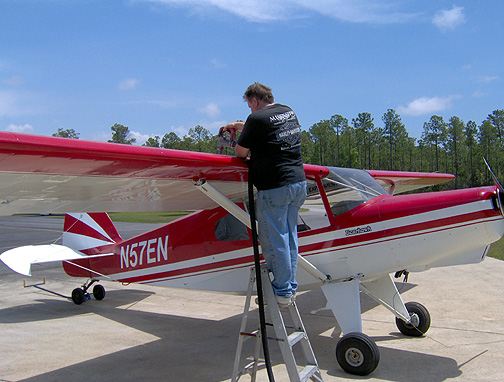
Actually the fuel didn't start showing up in the dipstick tube until we had 10 gallons in.
April 26, 2008
Today marks another of those "major achievement" days in the project. Today, the Miss'ippi Mudbug made real engine noises for the first time.
We started by removing all of the bottom spark plugs and then turning the engine over with the starter until we had good oil pressure. Since I had already done this previously, it took only to two rounds at six seconds each to show 45 PSI oil pressure.
The plugs were re-installed, torqued down and the plug wires were attached.
The airplane was then pushed out of the hangar and over to the fuel
pump (only about 50 feet away). The fuel was added 5 gallons at a time and
a fuel dipstick tube (Aircraft Spruce P/N 12-21260) was calibrated in 5 gallon
increments as we went.

Actually the fuel didn't start showing up in the dipstick tube until we
had 10 gallons in.
Both tanks were topped off (52 gallons total) with 100LL. I did this because I wanted to check how much the landing gear struts moved with full tanks (316 lbs) and me (260 lbs) on board. Not enough it turns out. They are still a bit cambered in, so some adjustment of the shock struts will be needed before I fly.
With the tanks, full and my crew of helpers standing by (father-in-law Lonnie
Gibbons and Son-In-Law Jason Thompson) with a fire extinguisher handy, it
was time to fire this thing off. We moved it about 30 feet away from
the fuel pump, faced it into the wind and gave it a go. Fuel Selector - BOTH,
Mixture- RICH, Master Switch - ON, "CLEAR PROP" , pump the throttle
once (no primer), throttle set at about 1/4" in from idle, key switch-
START:
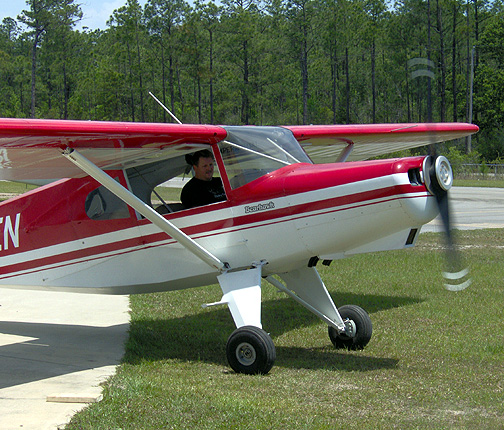
5 blades later, success!!!!!
Oil Pressure was 75 PSI and all engine parameters in the green. I ran
it at 800 RPM for exactly 3 minutes, then to idle (too low) and pulled the
mixture out (no RPM increase so too lean).
Next, the engine cowl was opened up and the engine was checked for leaks
or signs of fire or smoke:
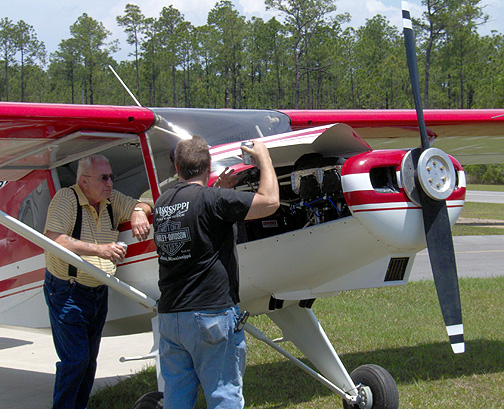
None found.
To make the mixture a bit richer, I turned the mixture adjustment screw 1/2 turn counter-clockwise. The idle stop screw was also adjusted to increase the idle a bit.
Of course the first engine run at a small airport where others are building
experimental airplanes always draws a few on-lookers to see what all the
hubbub is about:
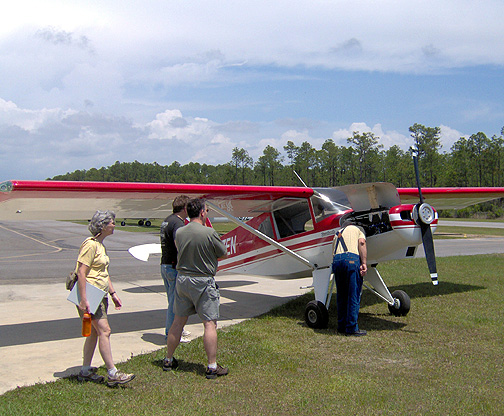
Since this is the first time this Bob Barrows built engine has been run, I have decided to follow the recommended engine run schedule put out by Mattituck engines. This is for an engine that has never been run in a test cell.
The rules for ground runs are never let the cylinder head temps (CHT) go above 350 degrees and limit any ground runs to 10 minutes. If the CHT's ever get to 350 degrees during ground runs, shut it down and let it cool until you can lay your hand on the aft cylinder for at least 5 seconds before continuing.. Face the nose into the wind for the following runs:
1. Run engine @ 800 RPM for 3 minutes. Shut it down and check for leaks. Let it cool until you can lay your hand on the aft cylinder and leave it there for at least 5 seconds without burning yourself.
2. Run engine @ 1000 RPM for 3 minutes. Shut it down and check for leaks. Let it cool until you can lay your hand on the aft cylinder and leave it there for at least 5 seconds without burning yourself.
3. Run engine @1200 RPM for 3 minutes. Shut it down and check for leaks. Let it cool until you can lay your hand on the aft cylinder and leave it there for at least 5 seconds without burning yourself.
4. Run engine @ 1400 RPM for 3 minutes. Shut it down and check for leaks. Let it cool until you can lay your hand on the aft cylinder and leave it there for at least 5 seconds without burning yourself.
5. Run Engine @ 1400 RPM for 5 minutes (watch those CHT's closely). Shut it down and check for leaks. Let it cool until you can lay your hand on the aft cylinder and leave it there for at least 5 seconds without burning yourself.
6. Run Engine @ 1400 RPM for 5 minutes, then run it at full power for a minute while checking engine parameters (do not exceed 350 degrees CHT), and check the static RPM . Pull it back to 1000 RPM for one minute. Shut it down and check for leaks. Put it back in service.
Once it's flying, do not exceed CHT's of 435 degrees or oil temps of 225 degrees until the engine is completely broke in and oil consumption has stabilized.
I was surprised at how long it took to cool down after each run. About
15 minutes or so. When it was time to do the full power run up, I taxied
the airplane over to a vacant spot near the runway with a tie down available.
The airplane was faced into the wind, tied down and the full power
runup was done.
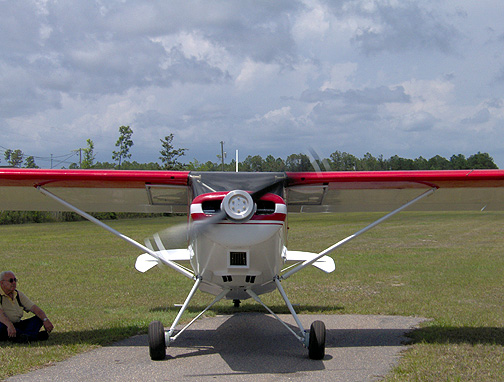
I got a static RPM (fixed pitch prop) of 2410 RPM. Also note
the camber on the main gear. The gear struts a need a little adjusting
outward.
Between runs, we sat under the wing in the shade with my helpers trying to
convince me to take it to the end of the runway and pour the coal to it "for
just one quick trip around the patch". NOPE - got to get my inspection
and some tailwheel time first.
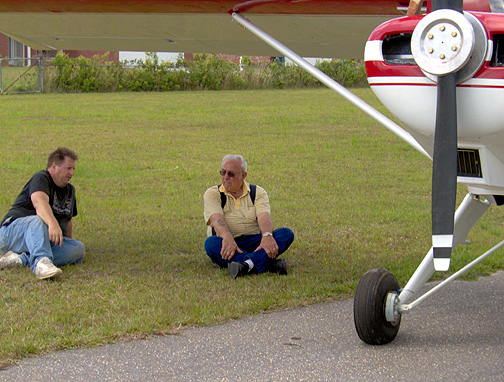
I can't say it wasn't tempting. Heck, even the Mudbug seemed to be
begging me to let go of the brakes. She was practically leaping off
the ground in anticipation of getting into the air.
When it was all over and time to taxi back to the hangar, I let Son-in-Law
Jason be the first to ride in the Mudbug:
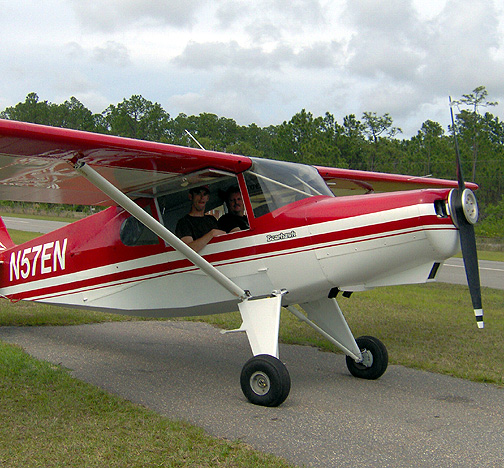
He's about 6'8" by the way and has head room and leg room to spare (but not
much)
Well that's about it. A totally successful first run of the engine. She sounded and felt strong and powerful. No oil leaks or issues. All parameters were normal and the Grand Rapids EIS system worked flawlessly.
Tomorrow is my final EAA tech counselor visit by Mickey Whittenburg. The DAR inspection is scheduled for May 10th. We took the Mudbug back to the hangar and stripped off the cowling and all inspection covers. I then splurged and treated my helpers to a nice meal at Wendy's. What a great day!
Click here to go to the Firewall Forward page
Click here to go to the Home page